I am studying the book Electric Circuits by Nilsson & Riedel. There I learned about "summing amplifiers" and how to derive equations by applying KCL at inverting input of the op amp. 
I see that solving equations result in this "voltage adding" behavior but I couldn't stop myself asking "Doesn't any current flow between those signals (voltage sources whose voltage values to be added) and doesn't that change how the whole circuit operates?" I cannot intuitively see why this circuit works.
Until today, I always thought that it is not wise to connect batteries with different voltage values in parallel (even with some resistor in between) because then the one with the higher voltage will try to charge the other battery(ies). Further, I remember watching the battery management system video of GreatScott! and that also gives me a feeling that no voltage source should be connected to each other in such "simple" manner.
If you could explain (preferably, like I am five) to me this summing op amp, I want to make a crude analog summing calculator. Thank you for any help.
